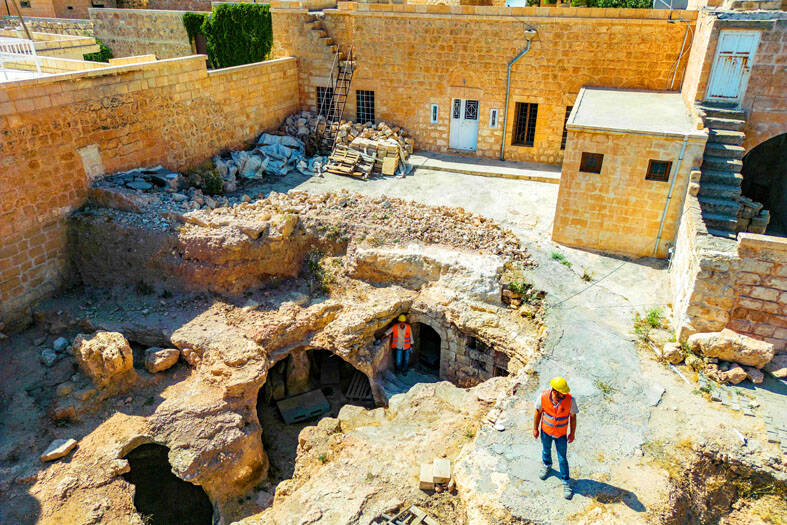Through a basement door in southeastern Turkey lies a sprawling underground city — perhaps the country’s largest — which one historian believes dates back to the ninth century BC.
Archeologists stumbled upon the city-under-a-city “almost by chance” after an excavation of house cellars in Midyat, near the Syrian border, led to the discovery of a vast labyrinth of caves in 2020.
Workers have already cleared more than 50 subterranean rooms, all connected by 120m of tunnel carved out of the rock.

Photo: AFP
However, that is only a fraction of the site’s estimated 900,000m2 area, which would make it the largest underground city in Turkey’s southern Anatolia region.
“Maybe even in the world,” said Midyat conservation director Mervan Yavuz, who oversaw the excavation. “To protect themselves from the climate, enemies, predators and diseases, people took refuge in these caves which they turned into an actual city.”
The art historian traces the city’s ancient beginnings to the reign of King Ashurnasirpal II, who ruled the Neo-Assyrian Empire from 883 to 859 BC.
At its height in the seventh century BC, the empire stretched from the Persian Gulf in the east to Egypt in the west.
Referred to as Matiate in that period, the city’s original entrance required people to bend in half and squeeze themselves into a circular opening.
It was this entrance that first gave the Midyat municipality an inkling of its subterranean counterpart’s existence.
“We actually suspected that it existed,” Yavuz said as he walked through the cave’s gloom. “In the 1970s, the ground collapsed and a construction machine fell down, but at the time we didn’t try to find out more, we just strengthened and closed up the hole.”
The region where the cave city is located was once known as Mesopotamia, recognized as the cradle of some of the earliest civilizations in the world.
Many major empires conquered or passed through these lands, which might have given those living around Matiate a reason to take refuge underground.
“Before the arrival of the Arabs, these lands were fiercely disputed by the Assyrians, the Persians, the Romans and then the Byzantines,” said Ekrem Akman, a historian at the nearby University of Mardin.
Yavuz said that “Christians from the Hatay region, fleeing from the persecution of the Roman Empire ... built monasteries in the mountains to avoid their attacks.”
He suspects that Jews and Christians might have used Matiate as a hiding place to practice their then-banned religions underground.
He pointed to the inscrutable stylized carvings — a horse, an eight-point star, a hand and trees — which adorn the walls, as well as a stone slab on the floor of one room that might have been used for celebrations or for sacrifices.
As a result of the city’s long continuous occupation, he said it was “difficult to pinpoint” exactly what at the site can be attributed to which period or group.
However, “pagans, Jews, Christians, Muslims, all these believers contributed to the underground city of Matiate,” Yavuz said.
Even after the threat of centuries of invasions had passed, the caves stayed in use, curator Gani Tarkan said.
He used to work as a director at the Mardin Museum, where household items, bronzes and potteries recovered from the caves are on display.
“People continued to use this place as a living space,” Tarkan said. “Some rooms were used as catacombs, others as storage space.”
Excavation leader Yavuz pointed to a series of round holes dug to hold wine-filled amphorae in the gloomy cool, out of the glaring sunlight above.
To this day, the Mardin region’s Orthodox Christian community maintains wine production using the vessels.
Turkey is also famous for its ancient cave villages in Cappadocia in the center of the country.
However, while Cappadocia’s underground cities are built with rooms vertically stacked on top of each other, Matiate spreads out horizontally, Tarkan said.
The municipality of Midyat, which funds the works, plans to continue the excavation until the site can be opened to the public.
It hopes the site will prove a popular tourist attraction.

The Burmese junta has said that detained former leader Aung San Suu Kyi is “in good health,” a day after her son said he has received little information about the 80-year-old’s condition and fears she could die without him knowing. In an interview in Tokyo earlier this week, Kim Aris said he had not heard from his mother in years and believes she is being held incommunicado in the capital, Naypyidaw. Aung San Suu Kyi, a Nobel Peace Prize laureate, was detained after a 2021 military coup that ousted her elected civilian government and sparked a civil war. She is serving a

‘NO AMNESTY’: Tens of thousands of people joined the rally against a bill that would slash the former president’s prison term; President Lula has said he would veto the bill Tens of thousands of Brazilians on Sunday demonstrated against a bill that advanced in Congress this week that would reduce the time former president Jair Bolsonaro spends behind bars following his sentence of more than 27 years for attempting a coup. Protests took place in the capital, Brasilia, and in other major cities across the nation, including Sao Paulo, Florianopolis, Salvador and Recife. On Copacabana’s boardwalk in Rio de Janeiro, crowds composed of left-wing voters chanted “No amnesty” and “Out with Hugo Motta,” a reference to the speaker of the lower house, which approved the bill on Wednesday last week. It is

‘EAST SHIELD’: State-run Belma said it would produce up to 6 million mines to lay along Poland’s 800km eastern border, and sell excess to nations bordering Russia and Belarus Poland has decided to start producing anti-personnel mines for the first time since the Cold War, and plans to deploy them along its eastern border and might export them to Ukraine, the deputy defense minister said. Joining a broader regional shift that has seen almost all European countries bordering Russia, with the exception of Norway, announce plans to quit the global treaty banning such weapons, Poland wants to use anti-personnel mines to beef up its borders with Belarus and Russia. “We are interested in large quantities as soon as possible,” Deputy Minister of National Defense Pawel Zalewski said. The mines would be part

Cozy knits, sparkly bobbles and Santa hats were all the canine rage on Sunday, as hundreds of sausage dogs and their owners converged on central London for an annual parade and get-together. The dachshunds’ gathering in London’s Hyde Park came after a previous “Sausage Walk” planned for Halloween had to be postponed, because it had become so popular organizers needed to apply for an events licence. “It was going to be too much fun so they canceled it,” laughed Nicky Bailey, the owner of three sausage dogs: Una and her two 19-week-old puppies Ember and Finnegan, wearing matching red coats and silver